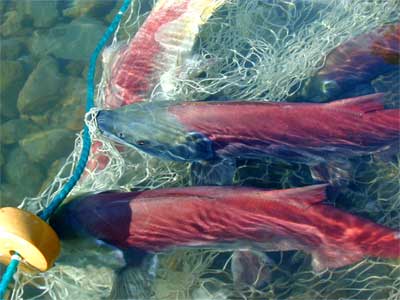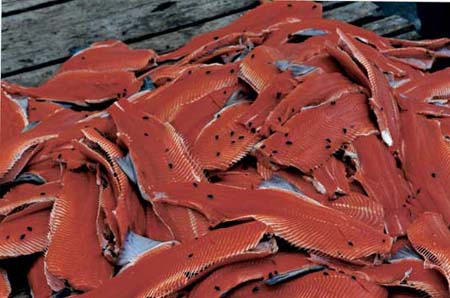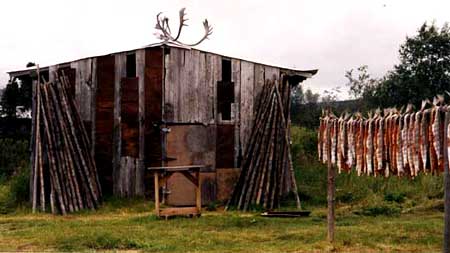Subsistence Fisheries
 |
Salmon Harvest
Subsistence fishing figures prominently in Bristol Bay communities. Athabaskan, Aleut, and Yup’ik peoples of Bristol Bayannually harvest about 150 thousand salmon which they eat fresh and dry, smoke, salt, pickle, can and store for winter sustenance, as they have for thousands of years. All 5 species of salmon are used, but Chinook, coho and sockeye salmon are the most popular food resource and comprise 60% to 80% of annual subsistence harvests (Fall et al. 1996, Fall et al. 2006; ADFG 2008).
|




|
Non-Salmon Subsistence Fish Harvest in Bristol Bay
Freshwater fish provide rural residents of Bristol Bay year-round subsistence opportunities, in contrast to salmon, which are captured only during specific time frames in summer and fall. For example, in the Kvichak watershed (Figure 1) 70 – 100% of rural households annually harvest 18,000 to 50,000 usable pounds of non-salmon fish to supplement their diets (Figure 2).
 |
| Figure 1. Villages and communities of the Kvichak River watershed; 70% to100% of households in these communities annually harvest from 18,000 to 50,000 pounds of non-salmon fish to supplement their diets. Click on image for a larger view. |
Humpback whitefish (Coregonus pidschian), Dolly Varden, (Salvelinus malma), and rainbow trout (Oncorhynchus mykiss) are important subsistence foods and the importance of a particular species to a community is generally related to its local availability (Figure 3). In Nondalton (Figure 1), whitefish are abundant during early spring through summer and about 75% of households participate in their harvest (Morris 1986, Stickman et al. 2003). Humpback whitefish are harvested using gillnets set under ice where springs feed into local lakes, or by ice fishing using single hooks baited with fish eggs. In the Lake Iliamna area, humpback whitefish are harvested with gillnets in fall and supply the largest non-salmon fish harvest in the community of Igiugig (Figure 1) providing food for residents of the region through a resource exchange network among villages (Morris 1986, Fall et al. 1996).
 |
| Figure 2. Estimated subsistence harvest of non-salmon freshwater fish in pounds useable weight per person, Kvichak River watershed, Bristol Bay Alaska. Graph from Krieg et al. 2005. Click on image for a larger view. |
 |
| Figure 3. Percent composition of the total non-salmon freshwater fish subsistence harvest in the Kvichak River watershed which ranges from 18,000 to 50,000 pounds per household per year (graph from Krieg et al. 2005). Note importance of Dolly Varden, rainbow trout, and whitefish to harvest in rural communities. Click on image for a larger view. |
Little scientific data are available on non-salmon fish life history, genetics, migration patterns, and essential habitats used for spawning, rearing, overwintering, or migration in the Bristol Bay region, although these species are an important year-round protein resource for local subsistence users. For example, it is unclear if humpback whitefish or Dolly Varden in the area migrate to saltwater habitats for part of their life cycle. Studies of whitefish earbones or otoliths do not show a clear pattern of saltwater use (This dearth of information on essential habitat use by fish throughout Alaska makes informed development decisions relative to fish conservation difficult.
The Nushagak and Kvichak River watersheds are the largest in Bristol Bay and they provide essential spawning, incubation and rearing habitats for five species of Pacific salmon and at least 14 resident fish species (Table 1).
Table 1. Common and scientific names of fish species known to occur
in the Nushagak and Kvichak River watersheds, Bristol Bay, Alaska. |
Common name |
Scientific name |
| Anadromous Salmon |
|
| sockeye salmon |
Oncorhynchus nerka |
| Chinook salmon |
Oncorhynchus tshawytscha |
| coho salmon |
Oncorhynchus kisutch |
| pink salmon |
Oncorhynchus gorbuscha |
| chum salmon |
Oncorhynchus keta |
| Resident Fish |
|
| longnose sucker |
Catostomus catostomus |
| northern pike |
Esox lucius |
| least cisco |
Coregonus sardinella |
| broad whitefish |
Coregonus nasus |
| humpback whitefish |
Coregonus pidschian |
| round whitefish |
Prosopium cylindraceum |
| Arctic grayling |
Thymallus arcticus |
| lake trout |
Salvelinus namaycush |
| Arctic char |
Salvelinus alpinus |
| Dolly Varden |
Salvelinus malma |
| rainbow trout |
Oncorhynchus mykiss |
| burbot |
Lota lota |
| threespine stickleback |
Gasterosteus aculeatus |
| ninespine stickleback |
Pungitius pungitius |
| slimy sculpin |
Cottus cognatus |
|
More information
Subsistence Fishing - Alaska Fish & Game
http://www.adfg.alaska.gov/index.cfm?adfg=fishingSubsistence.main
|
| |
Subsistence Fishing in Lake Clark
Text by Intern Kristy Balluta of Nondalton
Photos by Carol Ann Woody
Sockeye salmon fishing is very important to local people
around the Iliamna/Lake Clark area. Salmon is a main source of food
throughout the long cold winter. Salmon are dried, canned, and frozen
during the summer months, usually July to August. Many people depend on
the salmon for food, not only for the great taste but because it is
rich in vitamins and proteins. Salmon are usually processed at the
local fish camps around Nondalton. Here I describe how the people of
Nondalton capture and prepare their salmon harvest.
1. Local subsistence fishers capture fish in a gillnet.

2. Salmon inside a local family’s fish bin in Nondalton; ready to be cut and filleted.

3. Usually the men’s job is to go out and
catch the fish, they usually set their gillnets perpendicular to the
shore and leave them overnight. Then after they catch enough to process
they bring them back. The women take over then, cutting and processing
the fish.

4. Olga Balluta and Sophie Vasak cutting the fish and getting them ready to be hung on the drying racks.

5. Cutting or filletting the fish just
right is important. If you are preparing fish to be dried in the smoke
house and you cut the strips too thick, the strips could go sour. You
want the strips to be about an inch thick.

6. After the salmon is cut, the fish bones
are set aside and the bugs and gulls that are usually close by when the
fish are being processed, jump in. If any bones are left, they are
dumped back into the lake.

7. I interviewed June Tracey of Nondalton
about how she prepares rotten fish heads to be eaten. The picture below
shows a bunch of fish heads hung on a string in the water. She leaves
the fish heads in the water for about a week to ten days or until they
are floating. Then after that she takes it out of the water cleans it
thoroughly and eats the nose part of the fish with salt.

8. June Tracey of Nondalton hanging her salmon on her fish racks to dry.

9. Sophie Vasak of Nondalton cuts the fish so they can be hung inside the smokehouse to dry.

10. Here are well-prepared salmon hung on
drying racks at a local fish camp. After salmon are cut, they are put
on their racks outside to dry a little, usually 12-24 hours. Then they
are placed into a bucket of brine usually water, salt, and brown sugar.
After that they are hung inside the smoke house with a smoky fire of
alder or birch underneath. The salmon are usually left in the
smokehouse for a few days.

11. A smoke house in Nondalton that is used
to dry the salmon. The birch poles on the side of the smokehouse were
gathered by the men. The wood will be burned to flavor and dry the fish
in the smokehouse.

12. Here are salmon strips in a smokehouse above an alder fire.

13. Half dried salmon hanging inside the smokehouse.

14. June and Anna Rose Tracey of Nondalton
are canning partially dried salmon. The half dried salmon inside the
smoke house are taken down then cut into thin strips for canning.

15. The fish strips are put into jars and sometimes seasoned. They are then cooked inside of a pressure cooker.

16. Fresh salmon is also canned.

|
More information
Subsistence Fishing - Alaska Fish & Game
http://www.adfg.alaska.gov/index.cfm?adfg=fishingSubsistence.main
Subsistence in Alaska - Alaska Fish & Game
http://www.adfg.alaska.gov/index.cfm?adfg=subsistence.main
References
ADF&G 2007 Report (pdf file 1.95 mb)
ADFG (Alaska Department of Fish and Game). 2008. 2008 Bristol Bay Area Management Report. Fishery Management Report 09-30. Alaska Department of Fish and Game, Anchorage, AK.
Fall, J.A., D.L. Holen, B. Davis, T. Krieg, and D. Koster. 2006. Subsistence harvests and uses of wild resources in Iliamna, Newhalen, Nondalton, Pedro Bay, and Port Alsworth, Alaska, 2004. Alaska Department of Fish and Game, Division of Subsistence Technical Paper No. 302. Juneau.
Fall, J. A., M. B. Chythlook, J. C. Schichnes, and J. M. Morris. 1996. An overview of the harvest and use of freshwater fish by the communities of the Bristol Bay region, southwest Alaska. Alaska Department of Fish and Game, Division of Subsistence, Technical Paper Series. Technical Paper No. 166, 171 p. 
|


























